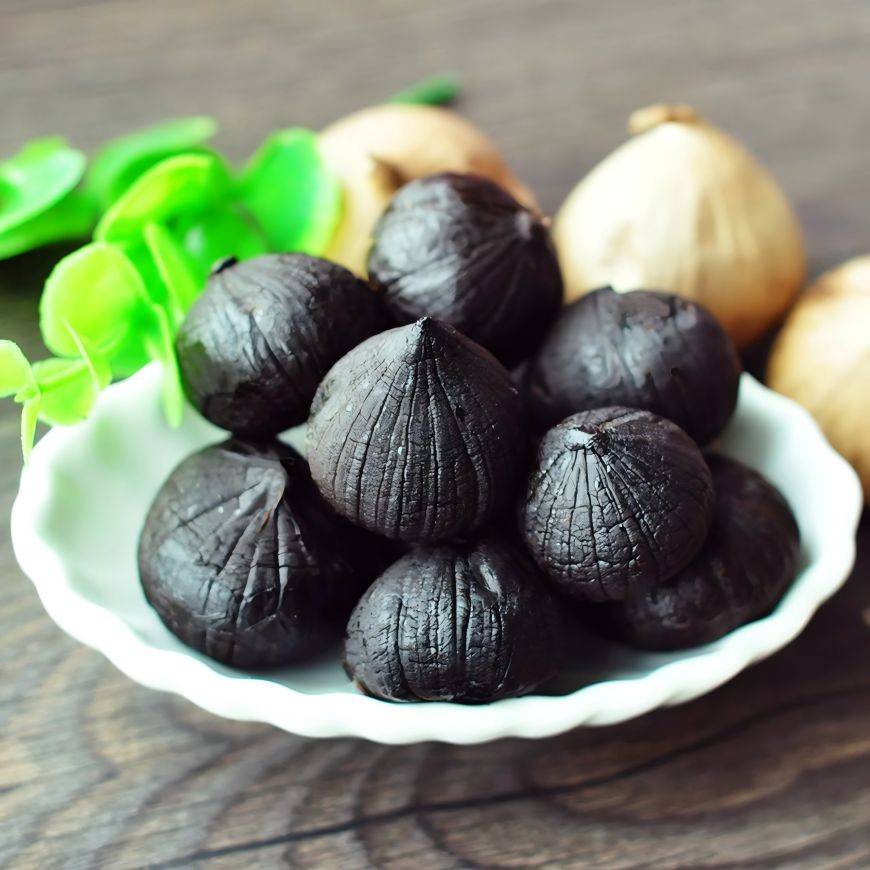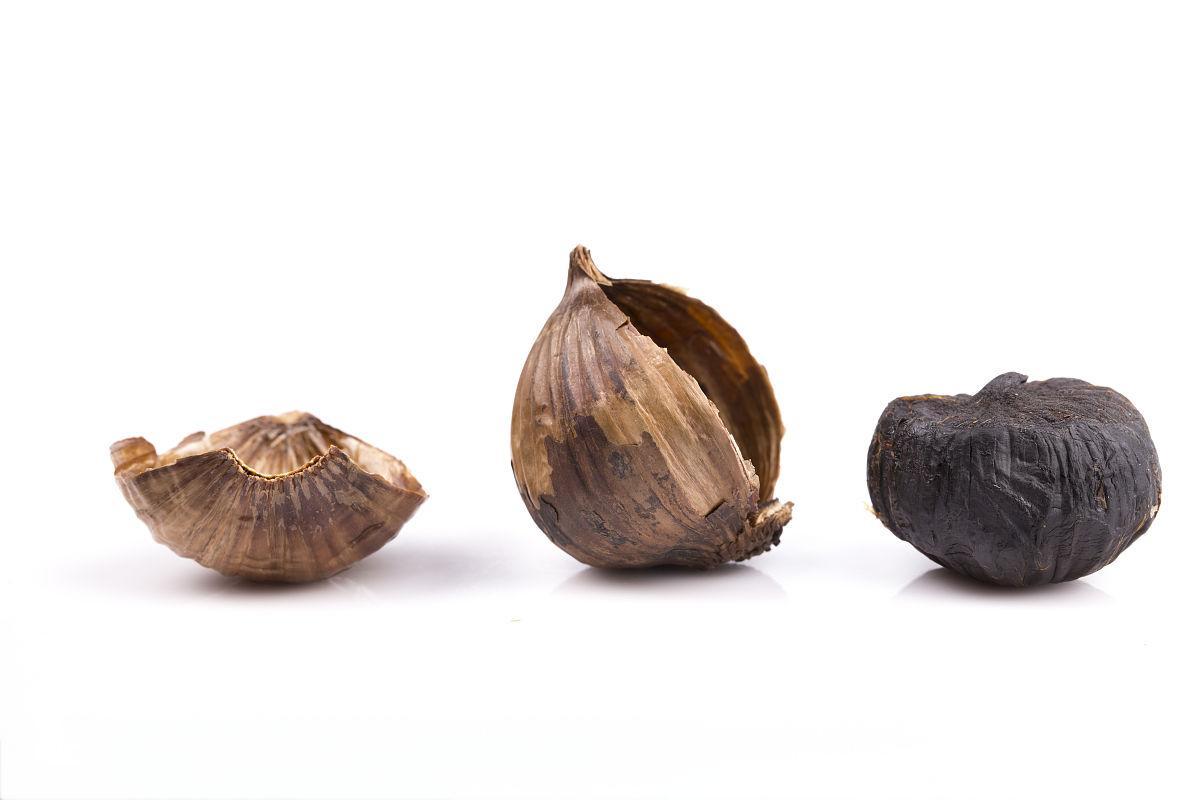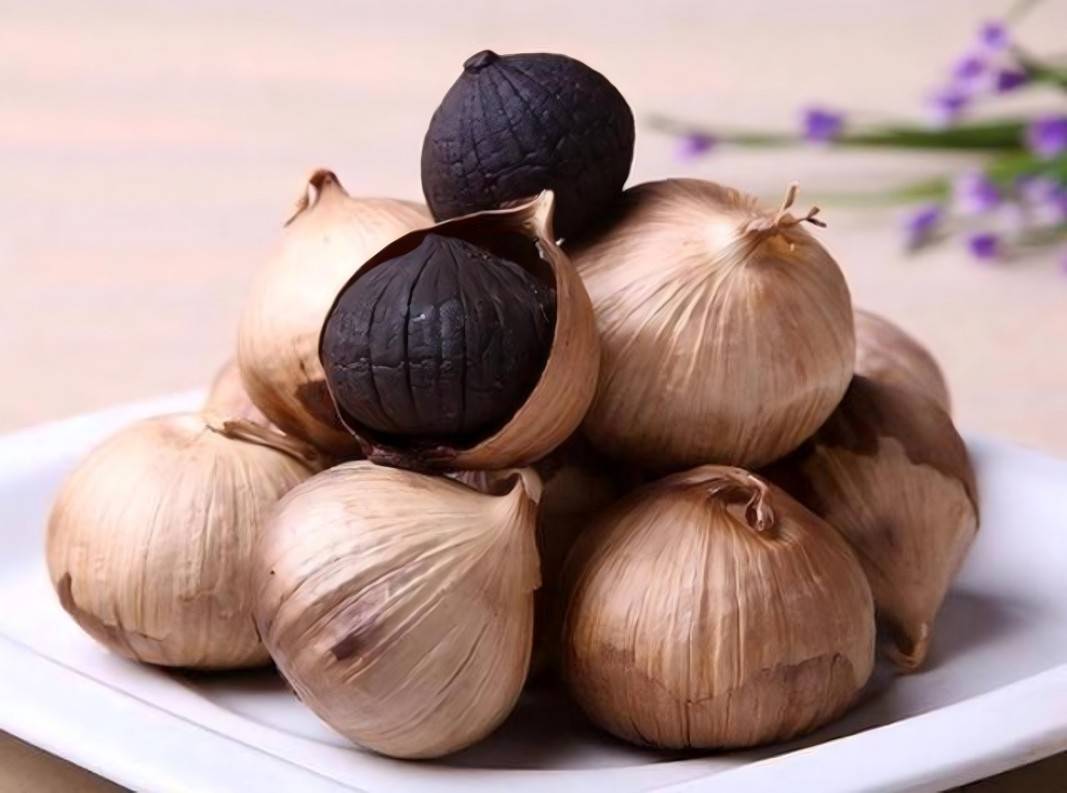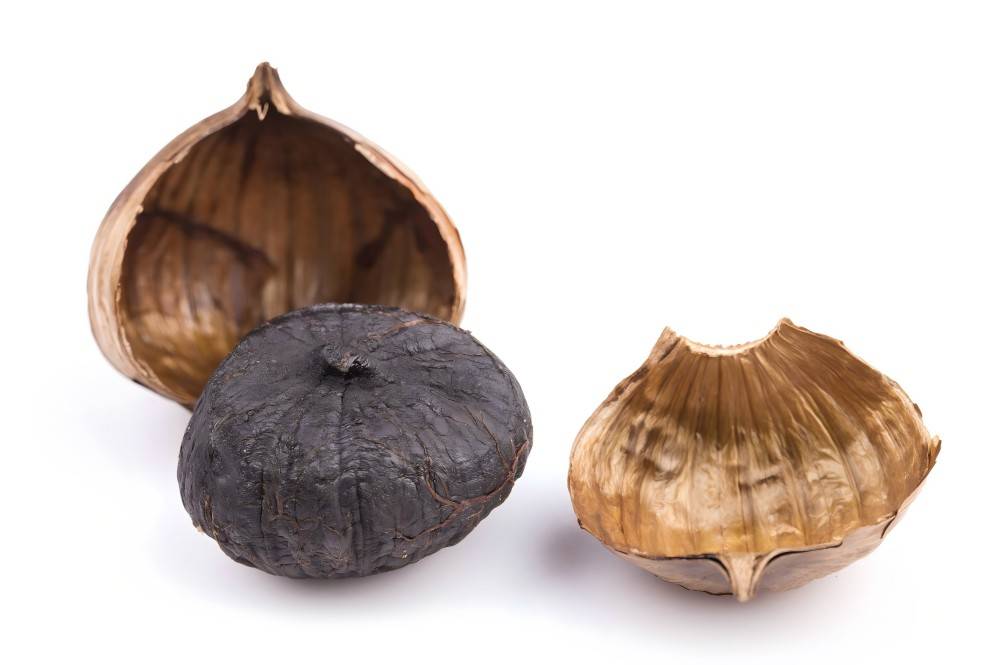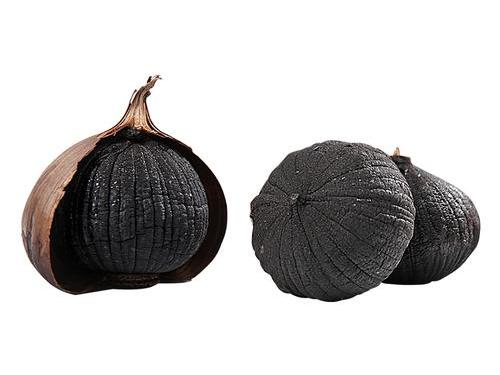Do You Know the Benefits Of Black Garlic?
Black garlic is a deep-processed garlic product that has become popular in recent years. It is made by fermenting fresh garlic for a period of time under controlled temperature and humidity [1]. The black garlic cloves are dark brown in color, slightly sweet in taste, and free of the pungent odor and spicy flavor of garlic. It does not cause bad breath after eating, alleviates some of the adverse reactions of garlic, such as gastrointestinal discomfort and contact dermatitis, and greatly broadens the market space of the garlic industry. Black garlic has only been around in China for a relatively short time. Although the exact origin of black garlic is unknown, it is generally believed to have originated in Mie Prefecture, Japan in 2003, and was subsequently introduced to China. In 2008, black garlic was exported from China for the first time. In less than 20 years, the black garlic industry has continued to develop and has become a key direction in the field of deep processing of garlic. This article provides a review of the active ingredients and physiological functions of black garlic, with the aim of providing a reference for the further development of black garlic health foods.
1 Active ingredients of black garlic
Black garlic is the product of enzymatic browning and the Maillard reaction in garlic. The black color is mainly due to the production of melanoidins, a product of the Maillard reaction. Compared with garlic, the chemical composition of black garlic has undergone significant changes, and while retaining some of the garlic components, new active ingredients have also been produced. Black garlic contains more than twice the amount of sugar, vitamins and protein as garlic, and the polyphenol content has increased significantly, being 11 times that of garlic. Zhou Guangyong et al. compared the differences in chemical composition between fresh garlic and black garlic. The results showed that the moisture and volatile organic sulfide content of black garlic decreased, while the sugar content and free radical scavenging capacity increased [2].
Wang Weidong et al. measured the changes in various components during the Maillard reaction of garlic. The moisture content of black garlic decreased to 56.5%, the polyphenol content increased to 5.4 mg·g-1, the reducing sugar content increased to 214.9 mg·g-1, the 5-hydroxymethylfurfural (5-HMF) content increased to 2729.12 μg·g-1, and the antioxidant capacity increased greatly. The reducing power and hydroxyl radical scavenging rate of black garlic were 10 times and 3 times those of garlic, respectively [3]. Lu Xiaoming's experiments showed that after garlic is processed into black garlic, the reducing sugar content increases from the initial 0.46 g/100 g to 39.49 g/100 g, an increase of nearly 100 times [4].
Kimura et al. summarized the changes in several amino acids, polyphenols, flavonoids and other ingredients in black garlic and fresh garlic (Table 1) [1]. Among them, the content of cysteine and tyrosine decreased after fermentation, while the content of leucine, isoleucine and phenylalanine increased. The Amadori & Heyns in black garlic is even 40 to 100 times that of garlic.
2. The physiological functions of black garlic
As a deep-processed product of garlic, black garlic has been proven to have strong physiological functions in both in vivo and in vitro functional experiments. This is related to the various active ingredients it contains, such as organic sulfides, polysaccharides, polyphenols and melanoidins, which together give black garlic antioxidant, liver protection, anti-tumor and other effects.
2.1 Antioxidant
Choi et al. studied the changes in antioxidant substances and antioxidant activity during the processing of black garlic. The results showed that flavonoids and polyphenols increased significantly under processing conditions of 70 °C and 90% humidity. By 21 days, the flavonoid content had increased from 3.22 mg RE·g-1 (RE is retinol equivalent) in fresh garlic to 16.26 mg RE·g-1 , polyphenols from fresh garlic 12.91 mg GAE·g-1 (GAE is gallic acid equivalent) to 58.33 mg GAE·g-1. The increase in antioxidant components leads to an increase in antioxidant capacity. The scavenging rate of black garlic for DPPH radicals can reach up to 74.48%, which is much higher than that of fresh garlic, and the scavenging rate for ABTS radicals is more than twice that of fresh garlic [5].
Du Rui Xue et al. measured the polysaccharide content and antioxidant capacity of fresh garlic and black garlic. The results showed that the polysaccharide content of black garlic was 98.67 mg·g-1, which was much higher than the polysaccharide content of garlic, which was 50.33 mg·g-1. The scavenging rates of the hydroxyl radical, DPPH radical, and superoxide anion radical of black garlic polysaccharides are all higher than those of garlic, indicating that black garlic polysaccharides have higher in vitro antioxidant capacity [6].
Zheng Lan et al. studied the in vivo antioxidant activity of black garlic polysaccharides in zebrafish. The results showed that the antioxidant rate of the low-dose intervention group of black garlic polysaccharides was 40.18%, while the antioxidant rate of the high-dose intervention group of black garlic polysaccharides was 50.6%, showing a significant dose-effect relationship and higher than the antioxidant rate of the vitamin C positive control group (11.38%) [7].
WANG Weidong et al. studied the in vitro and in vivo antioxidant activity of black garlic polyphenols. The results of in vitro experiments showed that black garlic polyphenols can significantly reduce the activity of DPPH free radicals and hydroxyl free radicals. The in vitro antioxidant activity of black garlic polyphenols at certain concentrations is higher than that of vitamin C. The results of in vitro experiments showed that black garlic polyphenols can significantly reduce the serum MDA content of mice with oxidative damage, increase serum SOD and GSH-Px activity, and exhibited significant in vivo antioxidant activity [8].
ZOU Ying et al. studied the protective effect of black garlic extract on red blood cells damaged by oxidation. The results showed that black garlic extract can significantly reduce the hemolysis rate of damaged red blood cells (AAPH-induced red blood cell hemolysis), and has strong intracellular antioxidant activity [9].
The antioxidant mechanism of black garlic is not yet fully understood. Ha et al. believe that the antioxidant activity of black garlic is related to the mRNA expression of Nrf2-related genes. The concentrations of thiobarbituric acid reactive substances (TBARS) and 8-isoprostanes (8-iso-PGF) in the plasma were measured, as well as the total antioxidant capacity (TAC) of the plasma and the activity of antioxidant enzymes in the plasma and liver. The mRNA expression levels of antioxidant-related proteins Nrf2, NAD(P)H:quinone-oxidoreductase-1 (NQO1), heme oxygenase-1 (HO-1), glutathione reductase (GR), and glutathione S-transferase-2 (GSTA2) were detected. The results showed that the plasma tbar concentration and TAC in the black garlic group were significantly lower, the activities of catalase and glutathione peroxidase were significantly higher, and the mRNA expression levels of Nrf2, NQO1, HO-1 and GSTA2 in the liver were significantly increased [10].
2.2 Antitumor effect
DONG Menghua et al. found that black garlic extract can inhibit the growth of HT29 colorectal cancer cells and further study its anti-cancer mechanism. Black garlic extract regulates the function of the PI3K/Akt pathway by upregulating PTEN and downregulating Akt and p-Akt expression, as well as inhibiting its downstream target 70 kDa ribosomal protein S6 kinase 1 at the mRNA and protein levels. It inhibits HT29 cell growth and induces apoptosis by inhibiting the PI3K/Akt pathway, thereby achieving the effect of inhibiting cancer cell growth [11].
Li Ying et al. studied the effect of black garlic extract on cervical cancer Hela cell transplants by constructing four groups of cervical cancer Hela cell transplant tumor models. Mice were randomly divided into four groups: the saline gavage group was the blank control group, the γ-ray irradiation group was the γ-irradiation group, the black garlic extract gavage group was the black garlic group, and the black garlic extract gavage combined with γ-irradiation treatment was the black garlic + γ-irradiation group. The growth rate of the tumors in each group of mice, the thymus and spleen indices, the lymphocyte stimulation index, the SOD activity value, CAT activity and white blood cell count. The results showed that black garlic extract can enhance the immune function of mice, improve their antioxidant capacity and peripheral blood white blood cell count, and exert a radiation sensitizing effect on Hela cell tumors [12].
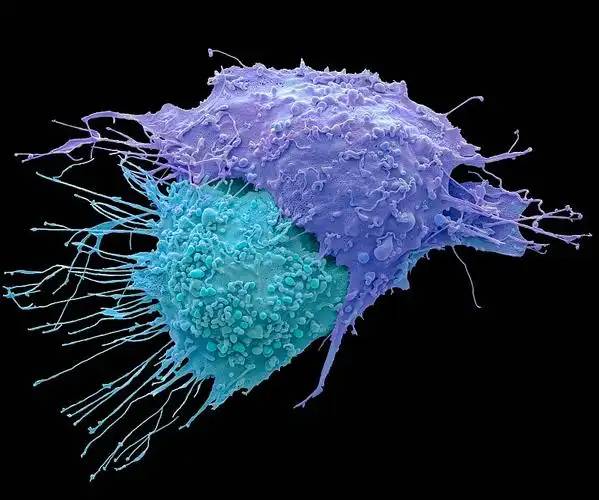
Gong Xiaojing et al. used tumor-bearing mice Panc-1 cells as the research object to explore the effect of black garlic extract on their growth and metastasis ability, and to study its molecular mechanism. A pancreatic cancer Panc-1 mouse metastasis model and a transplant tumor model were established respectively. The mice were randomly divided into four groups: a black garlic low-dose group, a black garlic high-dose group, a blank control group, and a positive control group. The blank control group was given 0.9% sodium chloride solution, and the positive control group was given cyclophosphamide. After 2 weeks, the mice were killed, the tumors were stripped and weighed, and the growth inhibition rate and metastasis inhibition rate of the tumors were calculated. The expression levels of Smad4 and TGF-β1 were detected. The results showed that the low and high dose groups of black garlic could significantly inhibit the growth and metastasis of Panc-1 cell transplant tumors, with a growth inhibition rate of up to 63.6% and a lung metastasis inhibition rate of up to 63.5%. and the metastasis inhibition rate of the high-dose black garlic group was higher than that of the positive control group. Compared with the blank control group, the low- and high-dose black garlic groups had fewer brownish-yellow TGF-β1 granules in the cytoplasm of Panc-1 cells and more yellow Smad4 in the cytoplasm. It can be seen that black garlic extract can significantly reduce the growth rate of mouse Panc-1 cell transplant tumors and their lung metastasis rate. The mechanism may be related to the TGF-β1/Smad4 signaling pathway, which inhibits tumor growth and metastasis by upregulating Smad4 expression and downregulating TGF-β1 expression in mouse Panc-1 transplant tumors [13].
2.3 Liver protection
Lee et al. used tert-butyl hydroperoxide (tBHP) to induce damage to rat clone-9 hepatocytes and studied the protective effect of black garlic on damaged hepatocytes. The results showed that black garlic extract can significantly inhibit the depletion of GSH, the accumulation of MDA, and the IL-6/IL-8 mRNA expression process, block lipid peroxidation and oxidative stress processes, and significantly reduce the death of tBHP-induced rat clone-9 hepatocytes [14].
Ahmed et al. studied the protective effect of black garlic on the hepatotoxicity and apoptosis induced by cyclophosphamide. The results showed that the liver tissue of the black garlic group was significantly improved, the hepatocytes were rearranged into radiating beams, the nuclei were normal, and no vacuoles or fat droplets were seen in the cytoplasm. The contents of ALT, AST, and bilirubin were significantly reduced, indicating that black garlic has a significant protective effect on hepatocyte apoptosis and liver tissue damage [15].
Zhang Yuan et al. established a mouse model of acute liver damage by gavage with 50% alcohol to study the effect of black garlic on acute alcoholic liver damage in mice. The results showed that high concentrations of black garlic can significantly reduce serum ALT in mice, reduce the degree of tissue damage in liver slices, and increase SOD activity, indicating that high concentrations of black garlic have a protective effect on acute alcoholic liver damage in mice [16].
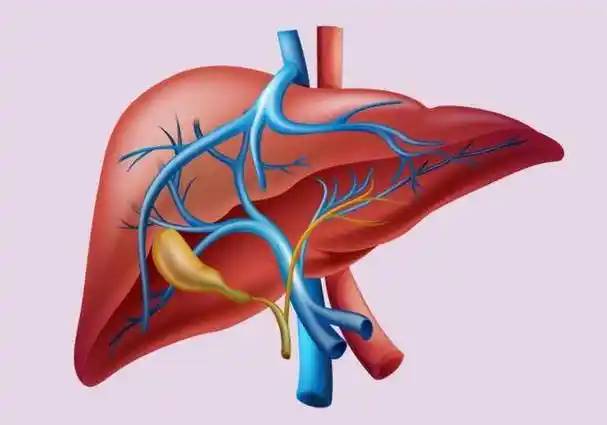
2.4 Regulate blood sugar and lipid levels
Ning Yuebao and others studied the hypoglycemic function of fermented black garlic, and the results showed that some sulfide substances in black garlic can lower blood glucose in mice [17]. Ao and others studied the effect of black garlic on cholesterol metabolism. The results showed that dietary supplementation with black garlic powder significantly inhibited the synthesis of cholesterol in the body [18]. Kim and others studied the antioxidant effect of black garlic extract and its effect on blood lipids. The results showed that high-fat-fed mice given black garlic extract by gavage had significantly lower plasma triglyceride and liver total cholesterol levels, thus improving blood lipids [19]. Nam et al. investigated the mechanism by which black garlic regulates lipid metabolism and showed that black garlic can regulate lipid metabolism by reducing the protein expression of the mature 3T3-L1 adipocyte proliferation factor activated receptor (PPAR) and cinnamoyl-CoA synthetase, inhibit the production of 3T3-L1 adipocytes, and promote the breakdown of fat to regulate lipid metabolism [20].
2.5 Immune regulation
There is still debate as to whether black garlic has physiological activity on the immune system. Among them, LI Min et al. compared the immune regulatory effects of garlic polysaccharides and black garlic polysaccharides, including the promotion of phagocytosis of RAW264.7 macrophages, the release of NO, and the expression of immune cytokines (IL-6, IL-10, tumor necrosis factor α and interferon γ) expression, the results showed that garlic polysaccharides have a stronger immunomodulatory effect, and black garlic polysaccharides have essentially no immunomodulatory activity [21]. Yang Ming et al. used BALB/c mice as the research object and established an animal model with cyclophosphamide, and found that black garlic powder in high, medium and low concentrations had an immune-enhancing effect on mice. Among them, the black garlic powder in high, medium and low-dose groups showed significantly higher antibody production, thymus index, spleen lymphocyte proliferation, and mRNA expression of IL-8 and IL-12 in spleen cells. The delayed hypersensitivity reaction and spleen index of mice in the medium- and high-dose groups were significantly higher. The phagocytic activity of monocytes-macrophages and the level of serum lysozyme in mice in the high-dose group were also significantly enhanced [22].
2.6 Anti-inflammatory effect
Jeong et al. identified and compared the antioxidant and anti-inflammatory effects of black garlic extract and fresh garlic extract. Hydrogen peroxide and lipopolysaccharide (LPS) were used as pro-oxidants and pro-inflammatory stressors, respectively. Compared with fresh garlic extract, black garlic extract had higher ABTS and DPPH free radical scavenging activity in RAW264.7 cells and produced less ROS. However, the inhibition of cyclooxygenase 2 and 5 lipoxygenase activity by fresh garlic extract was stronger than that of black garlic extract. In LPS-activated RAW264.7 cells, fresh garlic extract was more effective than black garlic extract in reducing the production of PGE, NO, IL-6, IL-1, LTD and LTE. After fresh garlic is fermented into black garlic, the combination of galactose, glucose, fructose or sucrose with fresh garlic extract reduces the anti-inflammatory activity, but also inhibits the activation of NF–κB and the expression of pro-inflammatory genes. The anti-inflammatory activity of black garlic extract is lower than that of fresh garlic extract, which may be due to the presence of sugars. Black garlic extract may be more helpful in the treatment of diseases mainly mediated by ROS [23].
Kim et al. studied the anti-inflammatory effect of functional compounds in black garlic using a lipopolysaccharide-induced inflammation model. The results showed that black garlic extract had a significant anti-inflammatory effect at certain concentrations. Cell viability, nitric oxide, prostaglandin E2 and pro-inflammatory cytokine (IL-6, TNF- α and IL-1β) levels were measured, and mRNA and protein expression levels of inducible nitric oxide synthase and cyclooxygenase-2 were detected by reverse transcription polymerase chain reaction and Western Blotting. The results showed that the levels of nitric oxide and prostaglandin E2 were significantly reduced with increasing concentrations of black garlic extract, and the secretion of IL-6, TNF-α and IL-1β was also inhibited, as was the mRNA and protein expression of inducible nitric oxide synthase and cyclooxygenase-2. In addition, black garlic extract also reduced the phosphorylation of extracellular signal-regulated kinase p38 and c-Jun terminal kinase induced by lipopolysaccharide in RAW264.7 cells [24].
2.7 Other
2.7.1 Laxative
Lu Xiaoming et al. found that after black garlic was administered to mice with a constipation model, the rate of advancement of the small intestinal contents increased significantly, the time to the first black stool was shortened, the number of black stool particles increased within 6 hours, and the moisture content of the stool increased, indicating that black garlic has a certain laxative effect [25].
2.7.2 Anti-fatigue effect
Du Juan et al. established a mouse exercise fatigue model and divided it into a swimming training group, a quiet control group, and low, medium, and high dose groups of black garlic. The results showed that the black garlic group had lower serum biochemical urea nitrogen, indicating that black garlic can regulate metabolic status and promote the excretion of metabolites; elevated blood glucose levels, restored liver glycogen and muscle glycogen levels, and reduced lactate dehydrogenase levels, indicating that black garlic can promote blood glucose and glycogen recovery; an increase in reduced glutathione content and total superoxide dismutase content indicates that black garlic can alleviate oxidative damage, improve exercise endurance, and resist exercise-induced fatigue [26].
2.7.3 Improves memory
Sun Yan found that black garlic extract significantly reduced the escape latency of mice (location navigation experiment), significantly increased the number of times mice passed through the platform and the ratio of time spent in the platform quadrant (spatial search experiment), and greatly improved the learning and memory abilities of mice with senile dementia caused by sodium nitrite and aluminum chloride [27].
2.7.4 Treating asthma
Li Yang et al. randomly divided mice into a blank control group, a negative group, a drug treatment group, a garlic group, and a black garlic group. Except for the blank group, the other four groups were sensitized with aluminum hydroxide and chicken egg protein, and induced with chicken egg protein to establish a mouse allergic asthma model. Each treatment group was injected with a solution of tiopronin fumarate, garlic extract, black garlic extract, while the blank group and negative group were injected with the same volume of PBS. The levels of IL-4, IL-33, IgE and IFN-γ in mouse serum were detected by ELISA, and the number of eosinophils in whole blood was counted under a microscope. The results showed that all treatment groups could effectively reduce the number of eosinophils and the levels of IL-4, IL-33, and IgE, and increase the level of IFN-γ. Among them, the black garlic group had statistically significant differences in all indicators (except IL-33) compared to the garlic group. This indicates that black garlic extract has a certain therapeutic effect on allergic asthma, and that the mechanism is mainly through adjusting the balance of Th1/Th2 responses, or through inhibiting the IL-33-ST2 signaling pathway [28].
2.7.5 Anti-allergy
Yoo et al. found that black garlic can significantly inhibit the immunoglobulin-mediated allergic reaction in RBL-2H3 cells and in vivo passive cutaneous anaphylaxis (PCA). In vitro experiments found that ethyl acetate extract of black garlic (EBG) significantly inhibited the release of acetylhexosaminidase and TNF- mouse serum. In addition, BG10, the active ingredient in EBG, significantly inhibited the release of tyrosinase-hexosaminidase and TNF- myeloperoxidase, and completely blocked the formation of prostaglandin E and leukotriene B at 25 μg·mL-1. It also reduced the phosphorylation of cytosolic phospholipase A (cPLA) and 5-lipoxygenase (5-LO) and the expression of cyclooxygenase-2 (COX-2) [29].
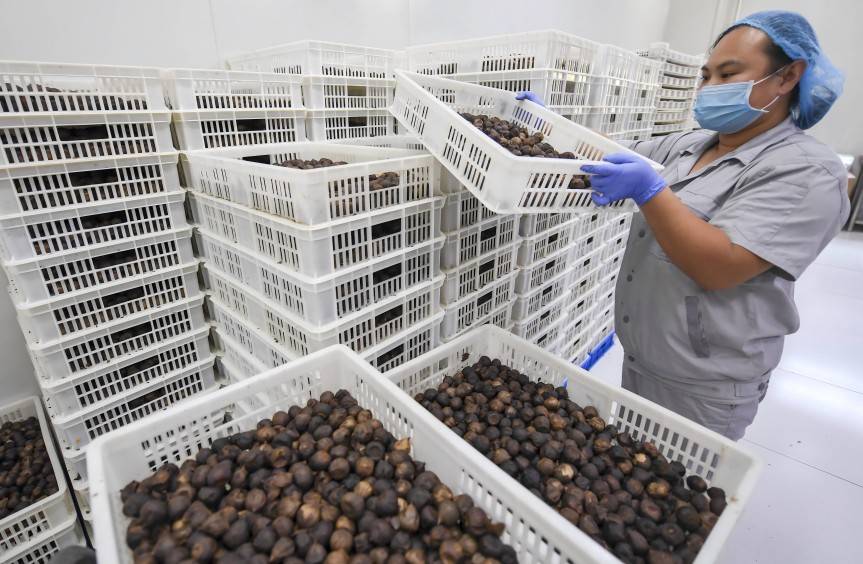
3 Conclusion
As an emerging product processed using modern technology, black garlic not only lacks the garlic odor and pungent taste, but also has greatly enhanced physiological functions, making it more in line with health and wellness needs and with huge market potential. Domestic scholars began researching black garlic in 2008, and related research has gradually increased since 2012, which reflects the momentum of black garlic development in China [30]. However, there is currently no unified quality standard for the production of black garlic, the production enterprises are small in scale, and the public's awareness of black garlic is not high, resulting in a very low market share. These problems seriously affect the further development of the black garlic industry. Therefore, it is necessary to improve the technological level and technical content of black garlic products, develop a black garlic technology sharing big data platform, and create new high value-added black garlic products. It is believed that with the gradual recognition of the nutritional value and physiological functions of black garlic by the public, black garlic will become an emerging health food product with huge market demand.
Reference:
[1]Kimura S,Tung Y C,Pan M H,et al.Black garlic: a critical review of its production, bioactivity, and application[J].Journal of Food & Drug Analysis,2017,25(1):62-70.
[2] Zhou Guangyong, Miao Yanshan, Chen Jieyu, et al. Changes in the main components and free radical scavenging capacity of black garlic during storage [J]. Chinese Journal of Food Science, 2010, 10(6): 64-71.
[3] Wang Weidong, Wang Ying, Wang Chao, et al. The effect of the Maillard reaction on the nutritional composition and antioxidant properties of garlic [J]. Food Science and Technology, 2013, 38 (4): 42-44, 48.
[4] Lu Xiaoming. Research on the production law and functional role of black garlic oligosaccharides [J]. Tai'an: Shandong Agricultural University, 2017: 35-36.
[5]Choi I S,Cha H S,Lee Y S.Physicochemical and Antioxidant Properties of Black Garlic[J]. Molecules,2014,19(10):16811-16823.
[6] Du Rui Xue, Wang Li Li, Zhang Chang, et al. Determination of polysaccharide content and research on antioxidant activity of garlic and black garlic [J]. Food Research and Development, 2019, 40 (18): 120-124.
[7] Zheng Lan, Ma Yaohong, Meng Qingjun, et al. Analysis of the antioxidant and anti-inflammatory activities of black garlic polysaccharides in zebrafish [J]. Chinese Journal of Food Science, 2020, 20(8): 65-75.
[8]WANG Weidong,SUN Yuee.In vitro and in vivo antioxidant activities of polyphenol extracted from black garlic[J].Food Science and Technology,2017,37(4):681-685.
[9]ZOU Ying ,ZHAO Mouming ,YANG Kun ,et al.Enrichment of antioxidants in black garlic juice using macroporous resins and their protective effects on oxidation-damaged human erythrocytes[J].Journal of Chromatography B, 2017,1060:443-450.
[10]Ha A W,Kim W K.Antioxidant mechanism of black garlic extract involving nuclear factor erythroid 2-like factor 2 pathway[J].Nutrition Research and Practice,2017,11(3):206-213.
[11]DONG Menghua,YANG Guiqing,LIU Hanchen, et al.Aged black garlic extract inhibits HT29 colon cancer cell growth via the PI3K/Akt signaling pathway[J].Biomed Rep,2014,2(2): 250-254.
[12] Li Y, Zhou Q, Wang YS, et al. Research on the radiation sensitization and protective mechanism of black garlic extract on cervical cancer Hela cell transplant tumors [J]. Chinese Journal of Traditional Chinese Medicine, 2018, 33(10): 1851-1855.
[13] Gong Xiaojing, Guo Na, Wang Yishan, et al. Black garlic extract inhibits the metastatic ability of pancreatic cancer Panc-1 mouse transplant tumors and the molecular mechanism [J]. Chinese Journal of Traditional Chinese Medicine, 2017, 32(10): 4648-4651.
[14]Lee K C,Teng C C,Shen C H,et al.Protective effect of black garlic extracts on tert-Butyl hydroperoxide-induced injury in hepatocytes via a c-Jun N-terminal kinase-dependent mechansm[J]. perimental and therapeutic medicine,2018,15(3): 2468-2474.
[15]Ahmed R A.Hepatoprotective and antiapoptotic role of aged black garlic against hepatotoxicity induced by cyclophosphamide[J].The Journal of Basic and Applied Zoology,2018,79:8.
[16] Zhang Yuan, Xu Binxin, Sun Wei, et al. Black garlic exerts a protective effect on acute alcoholic liver injury in mice through anti-oxidation [J]. Strait Pharmacy, 2019, 31(10): 24-27.
[17] Ning Yuebao, Chen Lijuan. Extraction of allicin from fermented solid black garlic and its hypoglycemic effect in mice [J]. Food Science and Technology, 2016, 41(1): 185-189.
[18]Ao X,Yoo J S,Zhou T X,et al.Effects of fermented garlic powder supplementation on growth performance,blood profiles and breast meat quality in broilers[J].Livestock Science, 2011,141(1):85-89.
[19]Kim D,Jung S J,Cheon S Y,et al.Antioxidant activity of Giant Black Garlic[J].Proceedings of the Nutrition Society,2013,72(OCE4): 15-18.
[20]Nam H,Jung H,Kim Y,et al.Aged black garlic extract regulates lipid metabolism by inhibiting lipogenesis and promoting lipolysis in mature 3T3-L1 adipocytes[J].Food Science and Biotechnology,2018,27(2):575-579.
[21]LI M in,YAN Y ixi,YU Qingtao,et al. Comparison of Immunomodulatory Effects of Fresh Garlic and Black Garlic Polysaccharides on RAW
264.7 Macrophages[J].Journal of Food Science, 2017,82(3):765-771.
[22] Yang M, Qin Y, Hao JY, et al. Effect of dietary black garlic powder supplementation on immune function in cyclophosphamide-induced BALB/c mice [J]. Food Science, 2019, 40(21): 163-170.
[23]Jeong Y Y,Ryu J H,Shin J H,et al.Comparison of Anti-Oxidant and Anti-Inflammatory Effects between Fresh and Aged Black Garlic Extracts[J]. Molecules,2016,21(4):430.
[24]Kim D G,Kang M J,Hong S S,et al. Antiinflammatory Effects of Functionally Active Compounds Isolated from Aged Black Garlic[J]. Phytotherapy Research,2017,31(1):53-61.
[25] Lu Xiaoming, Tian Jixin, Li Ningyang, et al. The laxative function of black garlic in constipated mice [J]. Chinese Journal of Food Science, 2019 (12): 39-43.
[26] Du Juan, Bian Xiaojun, Li Shanjie. Study on the extraction of polysaccharides from black garlic and its effect on exercise-induced fatigue [J]. Food Science and Technology, 2017, 42(11): 227-231.
[27] Sun Yan. Preparation of black garlic and study on its effect on learning and memory in mice [D]. Guangzhou: Guangdong Pharmaceutical University, 2017: 34-42.
[28] Li Yang, Li Shengjun, Chen Liudan, et al. Therapeutic effect of black garlic extract on allergic asthma in mice [J]. Chinese Journal of Clinicians (Electronic Edition), 2012, 6 (10): 2640-2643.
[29]Yoo J M, Sok D E, Kim M R.Anti-allergic action of aged black garlic extract in RBL- 2H3 cells and passive cutaneous anaphylaxis reaction in mice[J].Journal of medicinal food, 2014,17(1):92-102.
[30] Wang Jiangong, Hu Wenzhong, Jiang Aili, et al. Research progress on the production process, nutritional composition and biological functions of black garlic [J]. Food Industry, 2015, 36 (12): 232-236.


 English
English French
French Spanish
Spanish Russian
Russian Korean
Korean Japanese
Japanese